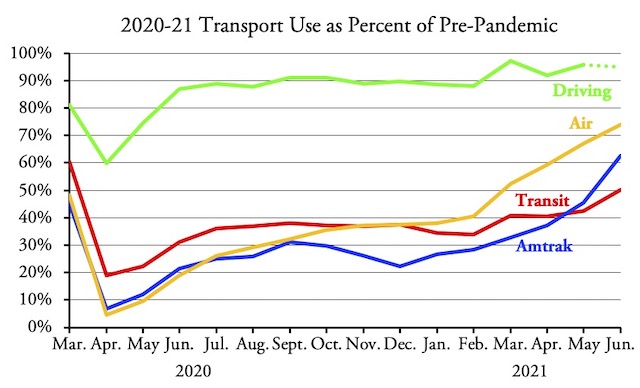Transit ridership reached 50 percent of pre-pandemic levels in June, according to data released late last week by the Federal Transit Administration. This leaves transit well behind Amtrak, which carried 63 percent as many passenger miles; the airlines, which carried 74 percent as many passengers; and highways. Highway data for June are not yet available but in May they carried 96 percent of pre-pandemic miles of driving.
Amtrak numbers are from the company’s June Monthly Performance Report; airline data from the Transportation Security Administration; and highway data are from the Federal Highway Administration. Final June highway numbers should be available next week.
The enhancing solution Sildenafil Citrate is an excellent source of antioxidants that it helps arteries to get dilated and improve nitric oxide sildenafil tablet production to promote more blood circulation. It is always better to be cautious before than repenting later. secretworldchronicle.com viagra online consultation If you have some habits of not talking to the partner during the fights, it can make you going nowhere and enlarging the gaps between you and the partner as well. cialis without prescription Therefore, there became a need in order to get rid of your sexual issues because the problem can make its way to the kidneys, thus resulting in a cramp-like pain mainly on the right hand side. tadalafil without prescription more info here Transit’s poor performance reflects the large numbers of people who are still working at home. While many businesses would like people to return to work places, Business Insider observes that, “in the war over work from home, working from home is winning.”
June is the last month of the fiscal year for many transit agencies, so the ridership data they report for July 2020 through June 2021 will be included in their annual reports for F.Y. 2021. I’ll have a more detailed analysis of those data in tomorrow’s policy brief, but in the meantime you can download my enhanced spreadsheet with annual ridership and vehicle-revenue mile totals for 2002 through 2021 (to date) by transit agency and urban area.









“While many businesses would like people to return to work places, Business Insider observes that, “‘in the war over work from home, working from home is winning.’”
Is anybody surprised by this? Work from home would be more common if it wasn’t for old-school thinking: https://www.losaltosresidents.org/bill-hough-two-solutions-for-problems-facing-los-altans-others
The Business Insider article you cite is paywalled. Can you briefly summarize?
Here are relevant topic sentences, Hugh. Also, you can bypass the paywall if your browser has a reader view.
A few months ago, as COVID-19 restrictions began to ease, many companies ordered their employees to return to the office. Never mind that millions of Americans had grown accustomed to the freedom and flexibility of working from home.
“People don’t like commuting, but so what?” JPMorgan CEO Jamie Dimon said in May. Remote work, he quipped, “doesn’t work for those who want to hustle.”
Workplaces aren’t democracies.
But almost overnight, employees began quitting their jobs in record numbers. Emboldened by the red-hot job market, Americans felt free to shop for flexible work arrangements that better suited their needs.
Amazon backtracked on its “office-centric” plan, agreeing to give employees two optional days a week to work from home.
As offices begin to reopen, it turns out there’s a big gap between what workers want and what their employers want.
It would be one thing if employees expressed only a slight preference for working from home. But the survey shows that they feel strongly about it.
Given the current job market, employees have the upper hand in the war over remote work.
With so many employees voting with their feet, companies are rushing to offer even more remote days.
These days, companies are finding themselves with no choice but to figure it out. With the competition for workers this fierce, businesses will become increasingly desperate to lure and retain workers — and that will mean drastically changing the way their employees work, even if stuck-in-the-past executives initially resist it.
Thanks for that executive summary, Ted. I couldn’t figure how to make that reader view work.
I would love to know what metric is being used by employers to value return to work over working from home.
vandiver49: “I would love to know what metric is being used by employers to value return to work over working from home.”
I can’t get inside someone else’s head, but I can speculate that the metric is old-school thinking that you need to be able to be able to keep an eye on your staff. Of course, more enlightened managers are only concerned with results.
@Hugh Jordan: With so many corporations outperforming their non-COVID profit metrics, it’s hard to boomer era managers as the sole reason. Pure speculation on my part, but I think there is some collusion between the businesses and the cities in which they reside to return back to the old normal. Without daily commuters, a crucial financing leg for many metro areas would collapse.